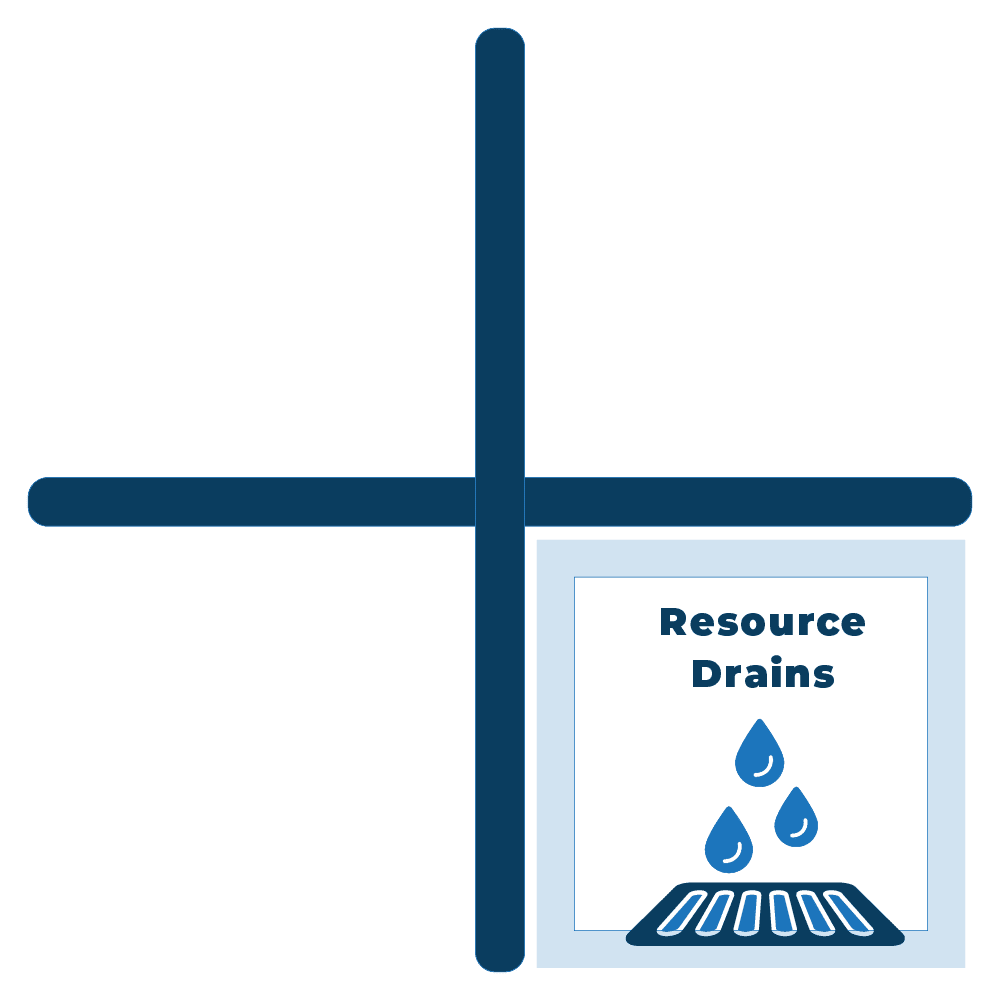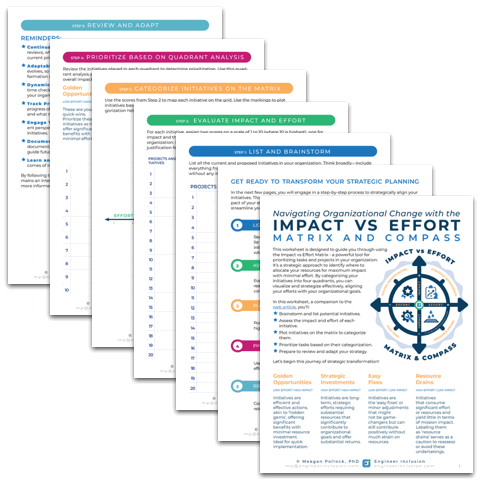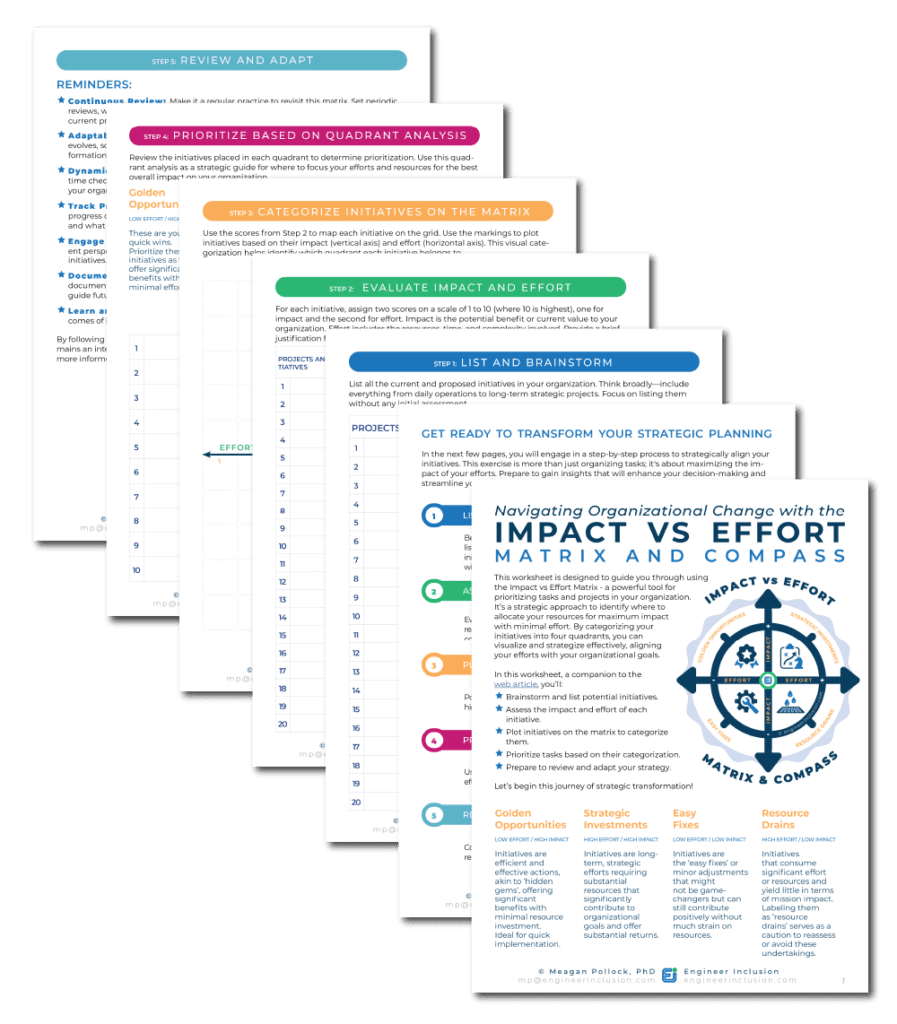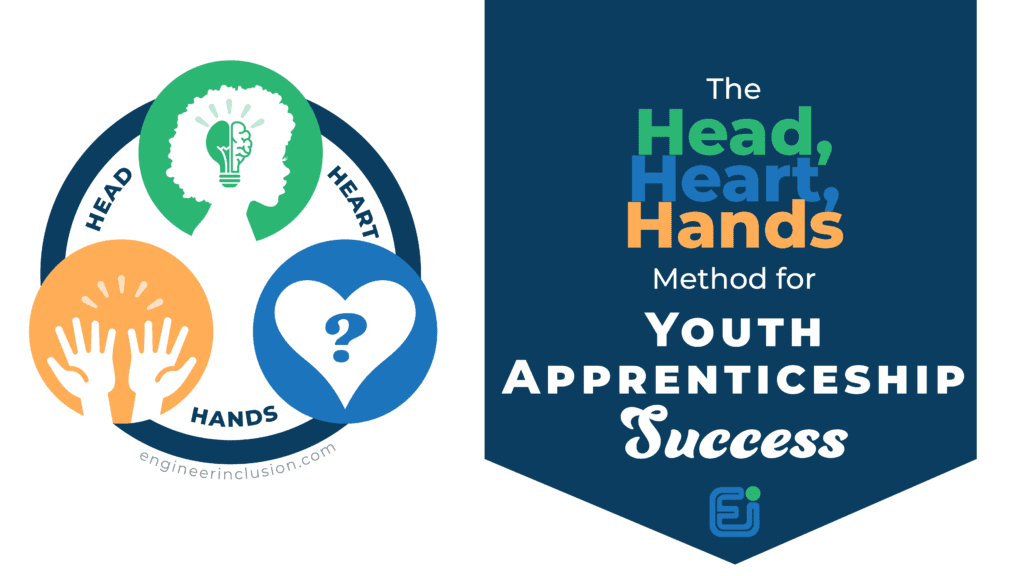Navigating the complexities of organizational change can often feel like charting through uncharted waters. To guide you on this transformative journey, we share the Impact vs Effort Matrix, a strategic compass designed to simplify decision-making and maximize efficiency in your change initiatives. This tool isn’t just a planner; it’s a crucial aid for aligning your projects with their potential impact and the effort they require. In this post, discover the essentials of the Impact vs Effort Matrix: its purpose, practical application, diverse examples, specific role-based use cases, and its critical role in enhancing root cause analysis and program improvement. Plus, as a bonus, download a complimentary worksheet featuring the matrix to kickstart your strategic planning.
Companion Resource
Download Your Free Guide
Transform your decision-making process and elevate your organizational strategy with our comprehensive Impact vs Effort Matrix guide. This essential resource, complete with practical templates and real-life case studies, is your key to aligning efforts with impactful results. Download now and start charting a course towards enhanced productivity and success!
DownloadWhy the Way You Prioritize Initiatives Could Be the Key to Transforming Your Organization
Imagine a world where every decision you make in your organization leads to impactful outcomes and optimal resource utilization. Sounds ideal, doesn’t it? Yet, in the bustling corridors of businesses and institutions, decision-making often becomes a complex puzzle. How do we sift through a multitude of ideas and initiatives to find those that truly matter? This is where the essence of strategic prioritization comes into play – a skill that could be the turning point in transforming your organization’s efficiency, teamwork, and overall success.
In the dynamic landscape of today’s work environments, understanding the ‘why’ and ‘how’ of prioritizing tasks is not just beneficial; it’s essential. That’s why the Impact vs Effort Matrix emerges as more than just a tool; it’s a compass guiding you through the maze of organizational decision-making. Whether you’re steering a startup towards new heights, managing a team in a multinational corporation, or leading change in an educational institution, the Impact vs Effort Matrix offers clarity amidst chaos.
In this article, we delve deep into how this matrix can revolutionize your approach to project prioritization, ensuring that your efforts align perfectly with impactful results and efficient resource allocation. So, buckle up and get ready to discover the secret ingredient to elevate your organizational strategy to the next level!

Understanding the Impact vs Effort Matrix
This matrix isn’t just a worksheet; it’s a compass for organizational change. It helps you plot the intersection of your efforts against two critical axes: ‘Effort’ and ‘Impact’. By categorizing initiatives into one of four quadrants, you can visualize where each action sits within these parameters and guide your strategy accordingly.

Golden Opportunities
This quadrant is for initiatives that pack a powerful punch with relatively little effort. Think of these as your organization’s ‘hidden gems’ – actions that yield significant results without a hefty resource commitment. They are highly efficient and effective, often overlooked but potent in driving change and improvement. Ideal for swift implementation, these initiatives can bring about immediate positive changes, boost morale, and set the stage for more extensive transformations. Examples could include simple process improvements, small-scale pilot programs, or quick technology upgrades that significantly enhance productivity or team dynamics.

Strategic Investments
These are the heavyweights of organizational change initiatives. High-impact, high-effort initiatives in this quadrant are the cornerstone of long-term strategic planning. They require substantial resources, time, and effort but promise to significantly advance your organization’s goals. These could be comprehensive policy reforms, large-scale technology implementations, major training programs, or extensive restructuring efforts. While they demand a considerable investment, the returns in terms of organizational growth, efficiency, and competitiveness are substantial and long-lasting.

Easy Fixes
The initiatives in this quadrant are the low-hanging fruit of organizational change. They are straightforward, requiring minimal effort, and while their impact might be modest, they still contribute positively. Easy Fixes are typically quick to implement and don’t strain your resources. They can be small policy tweaks, minor procedural adjustments, or simple communication improvements. These initiatives are often a good starting point for teams looking to gain quick wins or address simple issues that can lead to more significant changes over time.

RESOURCE DRAINS
This quadrant represents the initiatives that can be pitfalls for organizations. They are characterized by their high demand for resources and effort but yield only minimal impact. These might be outdated practices that continue to consume resources, projects that have veered off course, or new initiatives that are misaligned with organizational goals. They require a critical evaluation and, in many cases, may need to be scaled back, restructured, or discontinued. Recognizing and addressing these Resource Drains is crucial for preventing wastage and redirecting efforts towards more fruitful endeavors.
Why should you use the Impact vs Effort Matrix?
The Impact vs Effort Matrix serves as an essential tool for organizations and teams, offering several key advantages:

Objective Decision-Making
In environments where personal biases and subjective preferences can influence decision-making, the matrix provides an objective framework. By visualizing initiatives based on effort and impact, it helps teams move beyond individual perspectives to a more unified and strategic view.



Facilitating Productive Discussions
The matrix can spark constructive conversations, guiding teams to analyze and debate the merits of different projects. This process can lead to more thoughtful and informed decisions.



Countering the Planning Fallacy
People often underestimate the effort required for a project. The Impact Effort Matrix encourages realistic assessment of the effort needed for each initiative, helping teams plan more effectively and avoid underestimation.



Aligning Team Goals
The matrix helps ensure that everyone is on the same page regarding what the organization’s priorities are, aligning team efforts with overall objectives.



Resource Optimization
By identifying which projects offer high impact with manageable effort, the matrix aids in efficient resource allocation, ensuring that time, funds, and manpower are utilized where they can have the greatest effect.
Real-World Quadrant Examples: Navigating the Matrix
To better understand how the Impact vs Effort Matrix can be applied in practical settings, let’s explore some real-world examples. These illustrations across the four quadrants demonstrate how various initiatives can be effectively categorized and prioritized, guiding your decision-making in organizational change.
Golden Opportunities
- Flexible Work Arrangements: Implementing flexible work hours or remote work options to accommodate diverse life situations, enhancing employee satisfaction and productivity.
- Culture Committees: Forming small, agile teams focused on organizing cultural and team-building activities that promote inclusivity and teamwork.
- Transparent Communication Channels: Establishing open forums or regular town halls for transparent communication between leadership and staff, fostering trust and openness.
- Inclusive Meeting Practices: Implementing a rule to ensure every voice is heard in meetings.
- Recognition Days: Celebrating diverse cultures and identities with monthly recognition days.
- Accessibility Audit: Conducting audits for physical and digital accessibility improvements.
- Diverse Holiday Calendar: Including a variety of cultural and religious holidays in the company calendar.
Strategic Investments
- Comprehensive Inclusion Training: Developing in-depth training programs tailored to the organization’s specific needs, addressing unconscious bias, cultural competency, and inclusive leadership.
- Systematic Policy Overhaul: Undertaking a thorough review and update of all organizational policies to ensure they promote equity and inclusivity at every level.
- Innovative Collaboration Tools: Implementing advanced digital collaboration platforms that facilitate teamwork and innovation across diverse teams.
- Mentorship Programs: Establishing mentorship opportunities for underrepresented employees.
- Supplier Diversity: Creating a program to source from diverse suppliers.
- Inclusive Recruitment Strategies: Partnering with diverse organizations for wider talent recruitment.
- DEIJ Dashboard: Setting up a system to monitor and track diversity and inclusion metrics.
Easy Fixes
- Inclusion Tips in Newsletters: Adding a section in regular newsletters with tips or information on DEIJ, fostering ongoing awareness with minimal effort.
- Team Meeting Ice Breakers: Introducing short, inclusive ice-breaking activities in meetings to build rapport among team members.
- Casual Diversity Discussions: Hosting informal coffee chats or lunch-and-learns focused on diversity topics, encouraging open dialogue in a low-pressure setting.
- Feedback Boxes: Placing anonymous boxes for suggestions on inclusivity.
- Diversity Library: Creating a resource library on DEIJ topics for employees.
- Non-Discrimination Statement Updates: Keeping the non-discrimination statement current with inclusive language.
- Spotlight Features: Sharing diverse employee stories in company media.
Resource Drains
- Overly Complex Feedback Systems: Implementing intricate feedback mechanisms that are time-consuming and yield little actionable data on organizational culture.
- Redundant Reporting Requirements: Mandating excessive reporting on DEIJ metrics that do not directly contribute to actionable change.
- Multi-Layered Approval Processes for Initiatives: Creating complex approval chains for new ideas or initiatives, which can stifle creativity and slow down progress.
- Generic DEIJ Committees: Establishing committees without clear goals or roles.
- Over-Engineering Solutions: Investing in complex data systems with no clear usage plan.
- Broad Unfocused Training: Implementing generic diversity training not tailored to specific needs.
- Overly Ambitious Initiatives: Launching grand diversity charters without practical implementation plans.
How to Use the Impact vs Effort Matrix
The Impact vs Effort Matrix is a strategic tool that facilitates informed decision-making, helping teams across various domains, including DEIJ, to prioritize tasks and projects. Its primary goal is to enhance strategic thinking, efficiency, and realism in project management. Here’s how you can apply this matrix to achieve more successful outcomes in your organizational initiatives.



List Potential Initiatives
- Process: Start by compiling a comprehensive list of all current and proposed projects or initiatives within your organization. This list should be inclusive, covering everything from minor process changes to major strategic shifts.
- Purpose: This initial step serves to gather all possible initiatives in one place, providing a clear overview of what could be undertaken.



Assess Impact and Effort
- Process: For each initiative, assess two key dimensions: its potential impact and the effort required to implement it. Impact assessment should consider the potential benefits, the reach of the initiative, and how well it aligns with your organizational goals. Effort evaluation involves looking at the required resources, the time it will take, and the complexity of the task.
- Purpose: This step helps in understanding the trade-offs between the benefits an initiative could bring and the resources it would consume.



Plot on the Matrix
- Process: Based on the assessment, place each initiative into one of four quadrants on the matrix: high impact/low effort, high impact/high effort, low impact/low effort, or low impact/high effort.
- Purpose: This visual representation allows teams to quickly see which initiatives could offer the most significant benefits with the least effort, as well as those that might not be worth pursuing.



Prioritize Initiatives
- Process: Use the insights gained from the matrix to prioritize initiatives. Focus on the ‘high impact, low effort’ projects first, as these are likely to provide the best return on investment. Then consider the ‘high impact, high effort’ projects for their long-term benefits.
- Purpose: Prioritization ensures that resources are allocated to projects that align best with organizational goals and are feasible in terms of effort and impact.



Review and Adjust
- Process: Regularly revisit the matrix to update the status of various initiatives. As circumstances change, some projects might shift in their impact or effort level.
- Purpose: Continuous review and adjustment ensure that your prioritization remains relevant and responsive to the evolving needs and capacities of your organization.
By following these steps, teams can make more informed decisions about where to focus their efforts, ensuring that their actions align with organizational objectives and resource availability, and leading to more effective and impactful outcomes.
Use Cases by Role
The Impact vs Effort Matrix can be a versatile tool across various roles within an organization. Here’s how different positions might utilize the matrix to support organizational change initiatives:
HUMAN RESOURCES PROFESSIONALS
- Use: To evaluate and enhance recruitment practices, ensuring they are inclusive and reach a diverse candidate pool.
- Example: Using the matrix to assess the impact of partnering with minority-focused job boards against the effort and cost involved.
DIVERSITY AND INCLUSION OFFICERS
- Use: To plan and prioritize DEIJ initiatives across the organization, including training, policy development, and culture-building activities.
- Example: Mapping out the potential impact of a new inclusion training series versus the resources required for development and implementation.
SENIOR EXECUTIVES AND CEOS
- Use: For strategic planning and aligning DEIJ efforts with the overall business goals and objectives.
- Example: Determining the long-term sustainability and impact of implementing a company-wide mentorship program for underrepresented employees.
MANAGERS AND TEAM LEADERS
- Use: To foster an inclusive team environment and address any department-specific DEIJ challenges.
- Example: Assessing the benefits of regular team-building activities that celebrate diversity versus the effort to organize them.
MARKETING AND COMMUNICATIONS SPECIALISTS
- Use: To ensure that branding and external communications reflect the organization’s commitment to diversity and inclusivity.
- Example: Evaluating the impact of a social media campaign highlighting the company’s DEIJ efforts against the time investment required to create it.
TRAINING AND DEVELOPMENT COORDINATORS
- Use: To develop and refine educational programs promoting employee equity and understanding.
- Example: Measuring the effectiveness and resource allocation for an online course on cultural competency for all staff.
EMPLOYEE RESOURCE GROUP (ERG) LEADERS
- Use: To determine the most effective initiatives that support ERG members and align with organizational objectives.
- Example: Considering the impact of an ERG-led panel discussion on inclusion versus the effort needed to coordinate with panelists and promote the event.
PROCUREMENT OFFICERS
- Use: To integrate DEIJ principles into the supply chain and procurement processes.
- Example: Weighing the benefits of implementing a supplier diversity program against the investment required to vet and onboard new suppliers.
EDUCATION AND TRAINING CONSULTANTS
- Use: To advise educational institutions on embedding DEIJ into their curricula and administrative policies.
- Example: Gauging the impact of integrating DEIJ topics into existing curricula against the effort needed to train educators on these topics.
Each role can leverage the matrix to ensure that the time, effort, and resources invested into organizational change initiatives yield the highest possible impact and align with broader organizational values and goals.
Integrating Root Cause Analysis with the Impact Effort Matrix for Organizational Change
Effective organizational change, particularly in enhancing teamwork and productivity, requires a strategic approach. A crucial part of this strategy is combining Root Cause Analysis (RCA) with the Impact vs Effort Matrix. This combination ensures that interventions are deeply informed and targeted towards the most impactful outcomes.
THE PROCESS: FROM RCA TO STRATEGIC IMPLEMENTATION
- Conducting Root Cause Analysis:
- Begin with an in-depth RCA to identify underlying causes of challenges related to teamwork and productivity. This might involve analyzing team dynamics, workflow processes, or employee feedback to uncover core issues.
- Ideating Solutions:
- Following RCA, brainstorm potential solutions. This creative phase should focus on developing interventions that directly address the identified root causes and aim to enhance organizational efficiency and collaboration.
- Utilizing the Impact Effort Matrix:
- Assess each proposed solution with the Impact Effort Matrix. Evaluate how each solution ranks in terms of potential impact on teamwork and productivity versus the effort and resources required for implementation.
- Strategic Prioritization of Interventions:
- Place each intervention within the appropriate quadrant of the matrix: Golden Opportunities, Strategic Investments, Easy Fixes, or Resource Drains. Use this to guide prioritization.
- Emphasize interventions classified as Golden Opportunities (high impact, low effort) as they are likely to yield significant benefits with manageable investment.
THE VALUE OF THIS STRUCTURED APPROACH
- Informed Decisions: Root cause analysis ensures that solutions are not superficial but address the real issues hindering teamwork and productivity.
- Resource Optimization: This approach helps in allocating resources effectively, avoiding investments in low-impact initiatives.
- Maximizing Effectiveness: Prioritizing solutions identified through RCA increases their likelihood of success, directly tackling the specific challenges uncovered.
- Alignment with Organizational Goals: This method ensures that the chosen initiatives support the broader goals of enhancing teamwork, collaboration, and overall productivity in the organization.
By following this structured approach, organizations can make strategic and impactful decisions, leading to more effective and sustainable improvements in teamwork and productivity.
Elevate Your Strategy with Expert Guidance
Ready to revolutionize your approach to organizational change but need expert guidance? Contact us to leverage our specialized expertise in applying the Impact vs Effort Matrix. We offer personalized consulting services to help you align your initiatives, enhance teamwork, and boost productivity. Let’s collaborate to create a roadmap for success tailored to your unique organizational needs. Reach out today to start your journey towards strategic excellence!
DOWNLOAD A WORKSHEET TO GET YOU STARTED BELOW














